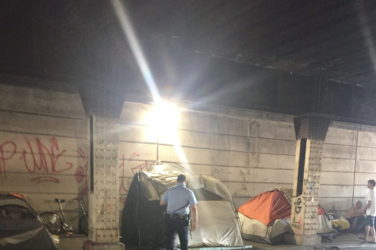On November 5, at the Astroworld festival in Houston, at least eight people were killed in what appeared, from multiple videos and eyewitness accounts, to be a stampede. By the next day, rumors were circulating online that the panic had been fueled by an unknown syringe-wielding assailant running through the crowd and injecting unsuspecting victims with drugs.
The origin of these rumors was Houston Police Chief Troy Finner, who in a November 6 press conference shared an unconfirmed interpretation of an incident involving an Astroworld private security guard. [Update, November 10: Finner walked back the following claim, stating that the guard himself said he suffered a blow to the head and that no one had injected drug into him.]
“I will tell you, one of the narratives was that some individual was injecting other people with drugs.”
According to Finner, the guard felt something on his neck. Some unknown length of time later, he fell briefly unconscious and was administered Narcan by onsite medical staff. They observed a mark on the guard’s neck, “similar to a prick that you would get if somebody is trying to inject.”
This narrative was snatched up by TMZ and led to a frenzy of online speculation that soon had “fentanyl” Twitter-trending in Texas.
Finner, in the same press conference, urged the public to “give us time to do a proper investigation”—time he himself had not bothered to take before using his platform to spread a baseless rumor at the expense of people who inject drugs.
It is possible, of course, that someone did sneak around the concert attempting to inject an unknown substance into the necks of strangers. But as an old teacher of mine liked to say, it’s also possible for a rhino to fall through my roof and crush me.
UPDATE: A source connected to Astroworld tells TMZ, someone in the crowd went crazy and began injecting people with some sort of drug. https://t.co/SdnZeXPleA
— TMZ (@TMZ) November 6, 2021
“The fact that someone was administered Narcan is not evidence that they were experiencing an opioid overdose,” Ryan Marino, an emergency medicine physician and medical toxicologist, told Filter. “I have seen plenty of cases where Narcan has been given to people who have fainted, who are experiencing a panic attack, or even where someone was just drinking alcohol, and while it may appear that they ‘responded,’ that is not always the case.”
Fentanyl can be fairly easily detected through rapid screens and toxicoligic testing. If there was indeed a shred of evidence that it was present in the security guard’s system, it surely would have been widely publicized by Finner and TMZ and everyone else.
“This would be easy to prove,” Marino said. “I am very skeptical of people blaming drugs without any evidence that drugs were present.”
Fearmongering about people who use drugs has long been driven by myths of needles wielded against innocent bystanders.
Tiny injection marks, like what the medical staff may have thought they saw on the guard’s neck, don’t look much different than small scratches or even an irritated hair follicle. And injecting a drug into someone takes more than a fraction of a second, and can’t really be done from arm’s length while running through a crowd. The plunger must be depressed, pressure applied, the distance between the two parties maintained.
Imagine when you last got a vaccination—it’s not a glancing “prick” that a nurse could have run past you and administered drive-by style without stopping.
Fearmongering about people who use drugs has long been driven by myths featuring needles wielded against innocent bystanders. In the 1980s and 1990s, early confusion about the infectiousness of HIV combined with rampant homophobia led to widespread rumors that people living with HIV were intentionally planting HIV-tainted needles in movie theater seats, gas station pump handles and vending machine coin returns.
Crowd crush, the phenomenon which is much more likely a factor in the concert deaths, is not always an intuitive one to grasp. When I was a new paramedic student, it had baffled me. How could someone be suffocated by simply having lots of people pressed against them?
I think we need some education on crowd crush!
I get it – I had a hard time understanding how this could be deadly when I began paramedic school.
This is an accessible primer on the issue, and explains how 8 people lost their lives on Friday. (It wasn’t The Mystery Stabber.) pic.twitter.com/x4l1Z1DjGG
— Claire Zagorski, MSc, LP (@clairezagorski) November 7, 2021
When experiencing crowd crush, our rib cage is so severely and consistently compressed that we become unable to take a breath, resulting in what’s called compressive asphyxia. Further compression also cracks bones, and those unable to stay on their feet find themselves trampled under wave after wave of panicked people.
There are a few things you can do if you find yourself caught in a gathering where crowd crush might develop. Pay attention to when groups of densely packed people start forming, and get away from these clusters as soon as you can. Avoid barriers like fences or walls, and do whatever you can to stay on your feet. You can buy a bit of room for your ribcage to expand by keeping your arms bent and tucked at your sides; like a boxer’s stance.
TMZ stated that its source was someone connected to the Astroworld festival, the producers of which are already facing civil litigation (and perhaps even criminal prosecution) from these tragic deaths. The concert production company LiveNation, which among many tasks was responsible for show security and safety infrastructure, was revealed to have a litany of previous Occupational Safety and Health Administration violations.
Crowd crush deaths are tragic, but ultimately this is a tangible, well-described medical phenomenon, the conditions for which seem to have been created by event organizers who didn’t follow safety regulations. We don’t need a syringe-wielding boogeyman to blame for the deaths.
“The widespread chaos that ensued in this tragedy is not consistent with drug exposure or effect,” Marino said. “Crowd crush is more than plausible; drugs are pretty implausible.”
Photograph via United States Fire Administration





Show Comments